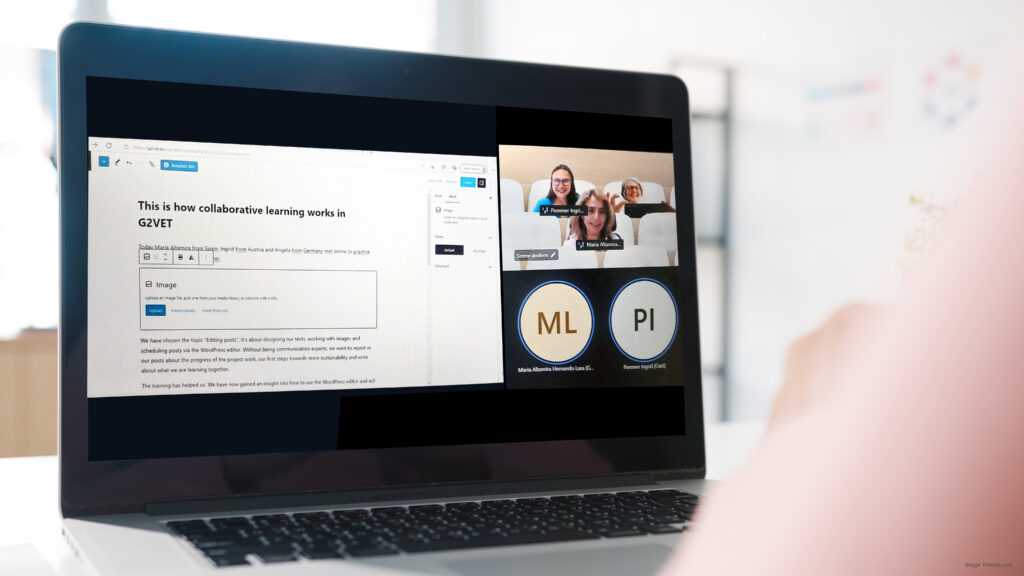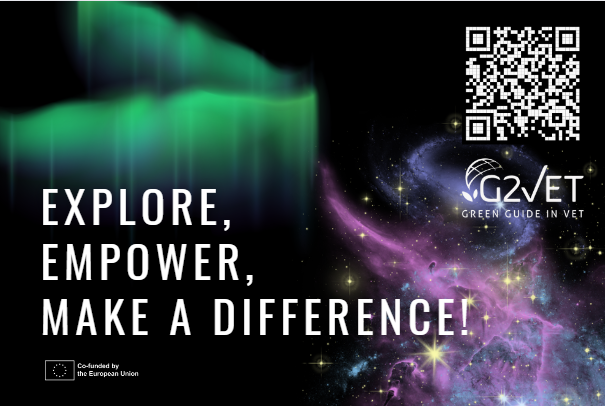This is about collaborative learning in G2VET

Today María Altamira from Spain, Ingrid from Austria and Angela from Germany met online to practice working with WordPress together.
We have chosen the topic “Editing posts”. It’s about designing our texts, working with images and scheduling posts via the WordPress editor. Without being communication experts, we want to report in our posts about the progress of the project work, our first steps towards more sustainability and write about what we are learning together.
The training has helped us. We have now gained an insight into how to use the WordPress editor and will be putting our posts on the blog in the coming weeks.
For our training we used the video conferencing app MS Teams. And this immediately raises the question of how energy and data consumption looks for online applications. How does online work look like with regard to energy and data consumption in order to be sustainable? We are pursuing this question and will report on it in the coming weeks.
Learning II: Creating and Editing H5P Files
Now it’s the End of September and the production of Lifehacks is running. This means that the project team learns a lot about sustainability in everyday life, in the workplace and tryes to apply this for training purposes. We have various topics in mind, which we work on as scripts – and then design interactively, using H5P. H5P seems to us to be a valuable tool for the creation of sustainable and flexible learning materials. H5P supports both ecological and pedagogical sustainability goals.
On 28 September 2023, we worked through the first steps for creating interactive learning content with H5P in an online workshop and are now looking forward to implementing it.
Get to know H5P and the possibilities: https://h5p.org/
Do you have any experiences? Then share them with us.


Sustainability in vocational education and training: a joint journey
On 17 November 2023, we went on a joint journey with colleagues for two hours on the topic of sustainability. This online workshop brought colleagues together as learners to discuss the importance and implementation of sustainability in vocational education.
To do this, we used a creative icebreaker in which participants shared their personal experiences and thoughts on the topic of sustainability using a hidden object picture. This led to further dialogue.
A short input presentation highlighted the various dimensions of sustainability – ecological, social and economic – and placed them in the context of vocational training. The discussion on how global sustainability goals can be broken down to the specific professional environment of the participants was particularly interesting.
Of course, we then presented the G2VET project, which is being implemented under the priority “Combating climate change” in ERASMUS+. Our colleagues were given an insight into the international cooperation and the project’s goals of anchoring sustainability more firmly in everyday and professional life in vocational education and training.
The practical part of the workshop focussed on options for action. In small groups, the participants developed ideas for a joint “sustainability challenge” for the upcoming Christmas period. We wish everyone every success with the implementation!
An important aim of the workshop was to get the participants involved in the G2VET community. Through the exchange of ideas and the joint development of challenges, we hope to have issued an attractive invitation to participate in the project.
Finally, resources and support options were presented to help participants implement sustainable practices in their professional environment.
The overwhelmingly positive feedback showed that the workshop was a first step towards getting more feedback. But also that there are already many committed and sustainable thinkers among us.
We look forward to implementing the impulses and further developing the ideas that have emerged. We invite all interested parties to become part of our G2VET project.
The workshop-entrance-image. It was done with DALL·E 2023-11-14 10.26.03 – A detailed hidden object picture, representing sustainability in Europe. The scene includes elements of renewable energy.
We cannot do without online collaboration in our project. There are many things to discuss – and to learn! To avoid travelling a lot, we try video conferencing. It works quite well.
But we know that we have to use online collaboration tools consciously in order to harmonise productivity and sustainability in the digital workplace.
In a study conducted by Greenspector in 2022, various video conferencing apps were compared and Microsoft Teams was among the top 3 in terms of energy consumption with a consumption of 83 mAh in all scenarios. But what does that mean? mAh stands for milliampere hours, a unit that measures the electrical charge. 83 mAh means that Teams consumes this amount of electrical energy in a given period of time (probably during a typical video conferencing session).
Is that a lot or a little? To put this into context: An average smartphone battery has a capacity of around 3000-4000 mAh. The consumption of 83 mAh by Teams would therefore account for about 2-3% of a full smartphone battery. This means energy consumption is noticeable, it’s not excessive compared to other common electronic devices and activities. But, sure, there is still room for improvement in its energy efficiency.
But it is not possible to make an effective statement about the resource impact of our workplaces with individual data. What matters is the overall impact in relation to its benefits and productivity. We’ll keep an eye on it!
Do you know how resources are being used at your workplace? Is there potential for savings or improvement?